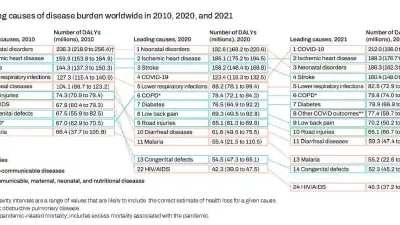Search results
Showing 21 of 2317 results
Disease burden: successes and challenges
Since 2010, the world succeeded in halving the burden of many diseases such as HIV/AIDS and diarrhea and slashing the disease burden from injuries by a quarter after accounting for differences in age and population size across countries.
Last updated
April 17, 2024
Global burden associated with 85 pathogens in 2019
We estimated disability-adjusted life-years (DALYs) for a wide range of infectious diseases, across 204 countries and territories.
Mohsen Naghavi, Tomislav Mestrovic, Christopher J.L. Murray, Authia Gray, Anna Hayoon, Lucien Swetschinski, Nicole Weaver, Kevin Ikuta, Erin Chung, Eve Wool, Chieh Han, Daniel Araki, Samuel Albertson, Rose Bender, Greg Bertolacci, Matthew Cunningham, Matthew Doxey, Sama Ghoba, Simon Hay, Rebecca Hsu, Hmwe Hmwe Kyu, Jorge Ledesma, Jianing Ma, Jon Mosser, Vincent Mougin, Amanda Novotney, Chris Troeger, Avina Vongpradith, Han Wunrow
April 16, 2024
Global, regional, and national incidence and mortality burden of non-COVID lower respiratory infections and aetiologies, 1990-2021
In 2020 and 2021, pandemic-associated non-pharmaceutical interventions such as physical distancing reduced not only the transmission of COVID-19, but also the transmission of other lower respiratory infections.
Rose Bender, Hmwe Hmwe Kyu, Mohsen Naghavi, Christopher J.L. Murray, Sarah Sirota, Lucien Swetschinski, Regina-Mae Dominguez, Amanda Novotney, Eve Wool, Kevin Ikuta, Avina Vongpradith, Emma Rogowski, Chris Troeger, Samuel Albertson, Jiawei He, Kelsey Maass, Katrin Burkart, Sinclair Carr, Eunice Chung, Xiaochen Dai, Lalit Dandona, Rakhi Dandona, Luisa Sorio Flor, Emily Haeuser, Tomislav Mestrovic, Ali Mokdad, Vincent Mougin, Bobby Reiner, Austin Schumacher, Reed Sorensen, Peng Zheng, Aleksandr Aravkin, Theo Vos, Simon Hay, Jon Mosser, Stephen Lim
April 15, 2024
Acute glomerulonephritis
Last updated
April 8, 2024
Acute hepatitis
Last updated
April 8, 2024
Alcohol use disorders
Last updated
April 8, 2024
Alcoholic cardiomyopathy
Last updated
April 8, 2024
Alzheimer’s disease and other dementias
Last updated
April 8, 2024
Amphetamine use disorder
Last updated
April 8, 2024
Anorexia nervosa
Last updated
April 8, 2024
Appendicitis
Last updated
April 8, 2024
Ascariasis
Last updated
April 8, 2024
Asthma
Last updated
April 8, 2024
Bacterial skin diseases
Last updated
April 8, 2024
Cancers
Last updated
April 8, 2024
Aortic aneurysm
Last updated
April 8, 2024
Cardiomyopathy and myocarditis
Last updated
April 8, 2024
Cardiovascular diseases
Last updated
April 8, 2024
Cellulitis
Last updated
April 8, 2024
Chagas disease
Last updated
April 8, 2024
Chronic kidney disease
Last updated
April 8, 2024
